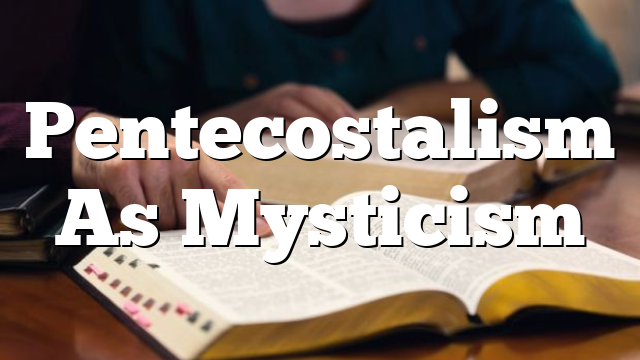Click to join the conversation with over 500,000 Pentecostal believers and scholars
Click to get our FREE MOBILE APP and stay connected
| PentecostalTheology.com



PNEUMA 40 (2018) 453–455
Pentecostalism as Mysticism The Catholicity of the Tradition
Historical, sociological, and theological assessments of Pentecostalism often focus on ways in which the movement is distinguishable from other expres- sions of Christianity. Historical accounts concentrate on various stages of development, commonly classified as Classical Pentecostalism, the Charis- matic movement, and the Third Wave. Owing in large part to the numerical growth and the geographical breadth of Pentecostalism, sociological analy- ses emphasize the unique cultural expressions found in particular locations. Dogmatic explanations of Pentecostalism draw attention to theological dis- tinctives, especially Spirit baptism and speaking in tongues. While focusing on distinguishing characteristics may be elucidating, Pentecostalism also has much in common with the larger Christian tradition. A primary example of the catholicity of Pentecostalism is its mystical spirituality.
In his groundbreaking work Pentecostal Spirituality, Steven Land sketched a view of Pentecostalism that proposed that the heart of the movement was its spirituality rather than dogmatic theology.1 His attention to the spiritual affections that have been forged by apocalyptic expectations reconsider Pen- tecostalism in relationship to the Christian mystical tradition. This resonates with James K.A. Smith’s depiction of pentecostal spirituality as a “radical open- ness to God, and in particular, openness to God doing something differently or new.”2The articles in this issue each contribute to an understanding of Pente- costalism that expound on the movement’s relationship to the larger Christian tradition.
This issue opens with the 2018 presidential address of Dale M. Coulter, titled “Recovering theWesleyanVision of Pentecostalism: 5Theses.” As Coulter states, his project is ambitious. He sketches a historical and theological vision of Pen- tecostalism by highlighting similarities between Wesleyan thought and prac- tice and Pentecostalism. The five theses are offered in support of his primary argument that “global Pentecostalism expands the Wesleyan vision to renew church and society by espousing a dissenting piety that prioritizes divine grace
1 Steven Jack Land, Pentecostal Spiritually: A Passion for the Kingdom (Sheffield, UK: Sheffield
Academic Press, 1993).
2 James K.A. Smith,Thinking in Tongues(Grand Rapids,MI: Eerdmans, 2010), 33.
© koninklijke brill nv, leiden, 2018 | doi:10.1163/15700747-04004026
1
454
waddell and althouse
within a via salutis whereby persons are increasingly caught up into God’s loving presence through Christ in the Spirit so that they might be sent out in mission for God.” Wesleyan Pentecostalism resonates with Christian mys- ticism in a variety of ways, including the soteriological marital metaphors of union and the quintessential mystical practice of Pentecostals—speaking in tongues.
Although speaking in tongues is not unique to Pentecostalism, it is, never- theless, a distinguishing feature of the movement. Previous pentecostal schol- arship has disputed interpretations that would seek to invalidate speaking in tongues, though those cessationist arguments were based on a particular read- ing of Paul’s statement in 1Corinthians that the gifts would cease once “the perfect” had come.3 In “When Will the Cessation of Speaking in Tongues and Revelatory Gifts Take Place?” B.J. Oropeza revisits this familiar topic, though from a new perspective. The article discusses recent grammatical interpreta- tions of 1Corinthians 13:8–10 by Daniel B. Wallace and James W. Scott—both of whom argue for the cessation of glossolalia, albeit from the middle voice in Greek or from the concept of a delayed Parousia (for Wallace and Scott, respec- tively). Oropeza integrates these arguments and reaffirms that Paul is claiming here that the gifts will not cease until the Parousia takes place.
In the next article, “Before There Were Charismatics: Charles Hamilton Prid- geon and Pittsburgh Pentecostalism,” Susan Lyn Moudry examines the life and ministry of a lesser known pentecostal leader. Although Pridgeon remained denominationally unaffiliated even after his initial pentecostal experience, the fact that he embraces the doctrine of ultimate reconciliation led the Assem- blies of God to identify his teaching as heretical. Moudry speculates that his belief in a temporary hell has contributed to his relegation to a footnote in pentecostal historiography, despite his commitment to the doctrines of heal- ing, holiness, and speaking in tongues.
In “Holding my Anchor in Turbulent Waters: God, Pentecostalism, and the African Diaspora in Belgium,” Joseph Bosco Bangura investigates the African Pentecostal diaspora church thriving in Belgium. Based in eleven years of observation and reflection in different African Pentecostal churches in Bel- gium, Bangura utilizes theological ethnography to argue that African Pente- costalism reconceptualizes an alternative view of God in which the rites of praise, prayer, prophetic proclamations, and pain coincide with pentecostal expectations of miracles, deliverance, and healing, thereby affecting individual
3 For example, Jon Ruthven,On the Cessation of the Charismata: The Protestant Polemic on Post-
biblical Miracles(Sheffield,UK: Sheffield Academic Press, 1993).
PNEUMA 40 (2018) 453–455
2
editorial
455
well-being and mediating prosperity. This reconceptualization of God has the effect of re-enchanting the world in the predominantly disenchanted context of the secular West.
Directly addressing Pentecostalism vis-à-vis mysticism, the final piece in this issue is a roundtable on Daniel Castelo’s Pentecostalism as a Christian Mystical Tradition.The book was the topic of a panel discussion at the 2018 annual meet- ing of the Society for Pentecostal Theology. The roundtable includes a response by Castelo to reviews offered by Kyle Smith from Rice University, Leah Payne from George Fox University, and Sammy Alfaro from Grand Canyon University. By situating Pentecostalism within the Christian mystical tradition, Castelo avoids the error of reducing to Pentecostalism to its distinctives, and he elu- cidates the heart of the movement and its connection with its religious and spiritual tradition.
Robby Waddelland Peter Althouse
PNEUMA 40 (2018) 453–455
3


